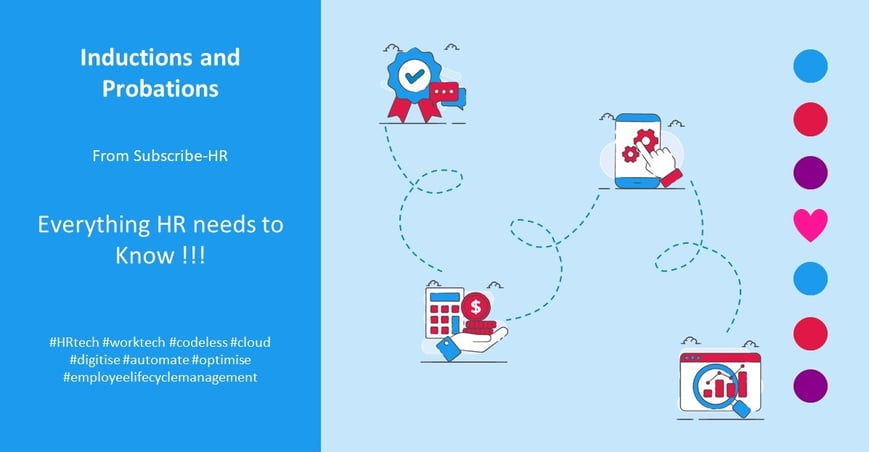As an employer or HR professional, you hold a significant influence in ensuring that new staff members settle into their roles and thrive in their new work environment. 👍
One of the most crucial tools at your disposal to achieve this is a comprehensive and effective induction process. During the early stages of employment, the first six months (or 12 months for small businesses with fewer than 15 employees) are designated as the probation period, also known as the Minimum Employment Period under the Fair Work Act.
In this blog post, we’ll be shedding light on the inductions and probations processes. Read on to find out everything you need to know about inductions and probations in Australia! ⬇️

What is Induction?
Understanding induction in HR onboarding
An induction in the workplace refers to a systematic process that businesses undertake when introducing new employees to their new work environment. This process aims to equip new hires with essential information related to their employment agreement, workplace facilities, colleagues, and organisational policies.
The content of a workplace induction is tailored to the specific operations and industry of the business. While the details covered in an employee induction may vary, they generally fall under similar categories, such as contract specifics and workplace safety protocols.
The purpose and importance of induction in the onboarding process
The purpose and importance of induction in the onboarding process cannot be overstated. Induction serves as the crucial foundation for a new employee's journey within the organisation, setting the tone for their entire experience.
It goes beyond just acquainting new hires with the workplace layout and basic procedures. Instead, it plays a pivotal role in integrating them into the company culture and fostering a sense of belonging.
.jpg?width=871&height=579&name=1%20(3).jpg)
Benefits of a well-executed induction process for new employees
- Enhanced Job Performance: New employees who undergo a comprehensive induction process are better equipped to understand their roles and responsibilities. This clarity leads to improved job performance and productivity from the outset. ✅
- Faster Integration: A well-structured induction ensures a faster and smoother integration of new hires into the company culture and work environment. They feel welcomed, supported, and connected to their colleagues, allowing them to become productive team members more quickly.
- Higher Employee Engagement: Engaged employees are more committed to their work and the organisation. A thoughtful induction process fosters a sense of belonging and loyalty, leading to higher levels of employee engagement and job satisfaction.
- Reduced Turnover: Effective inductions contribute to reducing employee turnover. When new hires experience a positive and supportive onboarding process, they are more likely to stay with the company in the long term.
- Positive Employer Branding: A well-executed induction sends a positive message about the organisation's commitment to its employees. This enhances the employer brand, making the company more attractive to potential candidates.
- Accelerated Time-to-Competency: Induction expedites the time it takes for new employees to reach full competency in their roles. It shortens the learning curve, allowing them to contribute effectively to the organisation's goals.
- Clear Expectations: During induction, new hires gain a clear understanding of the company's expectations, values, and performance standards. This clarity helps them align their efforts with organisational objectives.
- Increased Job Satisfaction: Feeling well-informed and supported from the beginning positively impacts new employees' job satisfaction. Satisfied employees are more likely to be motivated and committed to their work.
- Better Communication and Collaboration: Through induction, new hires establish connections with colleagues and superiors, fostering effective communication and collaboration within teams.
- Compliance and Risk Management: Induction ensures that new employees are aware of safety protocols, company policies, and legal requirements. This promotes a safe and compliant work environment, reducing potential risks for the organisation.
- Higher Retention Rates: A positive onboarding experience leads to higher retention rates. New employees who feel valued and integrated into the company culture are more inclined to stay with the organisation.
- Improved Employee Morale: A well-executed induction process boosts employee morale, as new hires feel supported and appreciated from the start of their employment.
What is Probation?
Definition of probation: assessing suitability for permanent positions
Probation refers to a designated timeframe within which employers evaluate the performance, capabilities and overall fit of new employees for permanent positions within the organisation.
➡️ During this probationary period, new hires undergo careful observation, assessment, and feedback to determine their compatibility with the company's values, culture, and job requirements.
The purpose and benefits of probation for employers and employees
The primary goal of probation is to ensure that both the employer and the employee have an opportunity to assess their mutual suitability for a long-term working relationship.
It provides an essential mechanism for employers to make informed decisions about retaining the employee permanently, ensuring that the individual is a valuable asset to the organisation.
Similarly, it allows new employees to gauge whether the company aligns with their professional aspirations and if the role meets their expectations and career goals. 🥅
Duration of probation periods: variances across industries and jurisdictions
The duration of probation periods can vary significantly across industries and jurisdictions. In general, the length of the probationary period is at the discretion of the employer, but it is often influenced by factors such as the complexity of the job, the level of training required, and the nature of the industry.
In some industries, where specialised skills or extensive training are necessary, probation periods may be longer to allow sufficient time to assess the employee's competency and suitability for the role. For example, in fields like healthcare or aviation, where safety and precision are paramount, probation periods may extend beyond the standard duration.

Legal implications and requirements in probationary periods
Probationary periods in employment have legal implications and requirements that both employers and employees need to be aware of. These implications and requirements vary depending on the jurisdiction and local labour laws, but some common aspects include:
- Termination without Notice: During the probationary period, employers often have the right to terminate employment without providing a lengthy notice period. This is usually to assess the suitability of the employee for the role and allows for more flexibility in managing workforce changes.
- Fairness and Non-Discrimination: Even during the probationary period, employers must adhere to principles of fairness and non-discrimination. Employees should not be terminated based on discriminatory factors such as age, race, gender, or disability.
- Entitlement to Basic Entitlements: While on probation, employees are entitled to certain basic entitlements, such as the minimum wage, leave accrual, and entitlement to work in a safe environment.
- Performance Assessment and Feedback: Employers are expected to provide feedback and conduct performance assessments during the probationary period. This ensures that the employee understands the expectations and requirements of the role.
- Probationary Period Limit: Some jurisdictions may impose limits on the duration of probationary periods to prevent employers from exploiting the period as a means to avoid providing full employment benefits.
- Extension of Probationary Period: In certain cases, employers may extend the probationary period if they require additional time to assess the employee's performance and suitability for the role.
- Termination for Cause: While termination without notice is allowed during the probationary period, it must still be for a valid cause. Employers must have legitimate reasons, such as poor performance or misconduct, to terminate an employee during probation.
- Probationary Policies: Employers should have clear and transparent probationary policies in place, outlining the process, expectations, and consequences of the probationary period.
- Documentation: Both employers and employees need to keep records of any communications, performance assessments, and feedback during the probationary period for legal purposes.
Induction vs Probation
Induction and probation are two distinct phases in the employee onboarding process, each serving different purposes and objectives. 👇
Induction
Definition: Induction, also known as onboarding or orientation, is the process of welcoming and introducing new employees to the organisation. It aims to familiarise them with the company culture, policies, procedures, and job expectations.
Purpose: The primary goal of induction is to help new employees assimilate into the organisation smoothly, so they become productive and engaged team members. It provides them with the necessary information and tools to perform their roles effectively from the outset.
Focus: Induction focuses on providing new employees with the knowledge and resources they need to adapt to their new work environment. It includes introducing them to colleagues, explaining the company's mission and values, and familiarising them with the organisational structure.
Duration: Induction usually occurs during the first few days or weeks of employment, depending on the complexity of the job and the organisation's onboarding process.
Probation
Definition: Probation is a specific period, usually at the beginning of employment, during which employers assess the performance, suitability, and cultural fit of new employees for permanent positions within the organisation.
Purpose: The main purpose of probation is to evaluate the new employee's capabilities, skills, and overall performance to determine whether they meet the required standards and align with the organisation's expectations.
Focus: Probationary periods are more performance-driven, focusing on monitoring the employee's job performance, adherence to company policies, and ability to work effectively within the team.
Duration: The length of the probationary period can vary depending on the employer's policies and local labour laws. In many cases, probation typically lasts for a few weeks or months, during which employers closely evaluate the employee's suitability for the role.

Key differences between Induction and Probation
- Induction is about orientation and getting new employees acquainted with the organisation, whereas probation is about assessing their performance and suitability for permanent employment.
- Induction emphasises providing a positive and welcoming experience for new employees, while probation is more focused on evaluating job performance and behaviour.
- Induction aims to help new employees become productive and engaged quickly, while probation allows employers to make informed decisions about the employee's long-term fit within the organisation.
The Induction Process: Step by Step
Pre-employment preparation
Before the new employee's first day, ensure all pre-employment preparations are in place. Communicate the start time, reporting instructions, and the activities planned for their first day. This sets the stage for a smooth onboarding experience.
Setting the foundation: introducing the company's mission, goals, and values
Kickstart the induction with a warm welcome and an overview of your company's mission, goals, and values. This helps new employees understand the organisation's purpose and align themselves with its vision.
Compliance and documentation: essential for new employees
Address compliance and documentation requirements early on. Provide the necessary information, including employment contracts, tax forms, and any other legal documents. This ensures a streamlined onboarding process and avoids delays. It’s good practice to include ⬇️
- Employment Contract
- Tax File Number (TFN) Declaration
- Superannuation Choice
- Bank Account Details
- Emergency Contact Details
- Personal Details Form
- Fair Work Information Statement
- Work Health and Safety (WHS) Policies and Procedures
- Employee Handbook or Policies Manual
- Privacy Policy
- IT and Security Policies
- Employee Benefits Information
- Acknowledgement and Consent
- Training and Development
- Probationary Period Confirmation
Easing new employees into the work environment: guided tours and introductions
Help new employees acclimate to their surroundings with guided tours of the workplace. Introduce them to their colleagues and team members, making them feel welcome and integrated into the team from day one. 🌈
Building a supportive team environment: appointing points of contact for new staff
Designate team members as points of contact or buddies for new employees. These mentors can offer guidance, answer questions, and provide support during the initial days, fostering a sense of belonging and camaraderie.

Social integration strategies: group meetings, welcome cards, and team lunches
Promote social integration by organising group meetings to facilitate introductions and build connections. Consider welcome cards from team members and team lunches to encourage a friendly and inclusive atmosphere.
The importance of post-induction follow-up: assessing employee integration and resource needs
Follow up with new employees after the initial induction period to assess their integration progress and address any resource needs. Regular feedback ensures a smooth transition and helps resolve any challenges they may be facing.
Continuous improvement: using feedback from follow-up to enhance induction programs
Seek feedback from new employees and incorporate their insights to continuously improve the induction process. This ongoing enhancement ensures that your onboarding program remains effective and relevant.
Regular meetings and confidential discussions: providing ongoing support to new employees
Schedule regular check-ins with new employees to offer ongoing support and address any concerns or questions they may have. Creating an open and confidential environment fosters trust and helps address potential issues proactively.
Probation

What to do when probation is not going well
When probation is not going well for an employee, employers need to address the situation promptly and effectively. Here are some steps to take when dealing with a probationary employee who is struggling 👇
- Early Identification: Monitor the employee's performance closely during the probationary period. Identify any issues or areas of concern as early as possible to address them proactively.
- Provide Feedback and Support: Schedule regular feedback sessions with the employee to discuss their performance and progress. Offer constructive feedback and support to help them improve.
- Set Clear Expectations: Reiterate the expectations and performance standards required for the role. Provide specific feedback on where the employee is falling short and outline the areas that need improvement.
- Offer Additional Training: If necessary, offer additional training or resources to help the employee develop the skills and knowledge required for their role.
- Define Improvement Plan: Work collaboratively with the employee to create a clear improvement plan. Set realistic goals and milestones to measure their progress.
- Monitor Progress: Continuously monitor the employee's progress against the improvement plan. Offer ongoing guidance and support to ensure they are on the right track.
- Regular Check-Ins: Schedule regular check-in meetings to discuss the employee's progress and address any challenges they may be facing.
- Everything is documented in your Employment Automation Software: Detailed records will be kept of all communication and actions taken during the probationary period. This documentation will be valuable in case termination becomes necessary.
- Timeframe for Improvement: Set a reasonable timeframe for improvement and communicate it to the employee. Be clear about the consequences if performance does not improve.
- Be Fair and Objective: Assess the employee's performance objectively, ensuring that the evaluation is fair and based on measurable criteria.
- Seek HR or Legal Advice: If the situation does not improve, consider seeking advice from HR or legal professionals to ensure you are following the correct procedures and complying with employment laws.
- Termination as a Last Resort: Termination should be considered as a last resort if the employee's performance remains unsatisfactory despite reasonable efforts to support their improvement.
- Provide Feedback: If the decision is made to terminate the employee, provide them with clear feedback and the reasons for the termination. Offer resources or guidance for future job searches.
Induction Checklist
Before the First Day
- Provide the new employee with essential information about their start time, who to report to, and what to expect on their first day.
- Ensure the line manager is available to spend time with the new employee and provide guidance.
- Arrange necessary equipment such as phone, computer, and workstation for a smooth start.
- Hand out hard copies of relevant documents, including the staff handbook and key policies, to familiarise the employee with the organisation's rules and guidelines.
- Develop a well-structured induction plan for the first 1-2 weeks, covering crucial information, important meetings, and a manageable workload to ensure better retention and understanding.
Reception
- Warmly welcome the new employee to the organisation.
- Complete all required personnel documentation and checks efficiently.
- Issue a security or identity card, if applicable, to grant access to relevant areas.
- Consider assigning a co-worker as a 'buddy' to offer support and guidance during the initial weeks
Introduction to the Organisation
- Introduce the new employee to key individuals across various departments or teams.
- Provide an informative overview of the organisation's history, its core activities, the services it offers, and future plans and developments.
Terms and Conditions of Employment
- Ensure the new employee receives a signed written statement outlining their terms and conditions of employment.
- Discuss key employment terms such as working hours, breaks, payment methods, holiday entitlements, flexitime or flexible working arrangements, probationary period, sickness provisions, reporting procedures, superannuation, and data protection policies.
Equal Opportunities Policy and Employee Development
- Present the equal opportunities policy to emphasise the organisation's commitment to fairness and non-discrimination.
- Highlight measures in place to prevent bullying and harassment, promoting a respectful and inclusive work environment.
Training
- Provide information about available training opportunities and further education options for personal and professional growth.
- Explain the performance appraisal process and how it contributes to employee learning and career advancement.
Employee/Employer Relations
- If relevant, discuss trade unions and other employee representation channels to ensure effective communication between employees and management.
- Explain the employee communications and consultation procedures to foster transparency and involvement.
- Inform the new employee about the grievance and disciplinary procedures, including the appeals process, to ensure a fair and consistent approach.
Organisation Rules/Facilities
- Clearly explain the general behaviour and dress code expectations within the workplace.
- Provide information on the IT policy, including guidelines for personal device usage in the workplace.
- Show the location of the canteen and break facilities for the employee's convenience.
- Indicate the cloakroom and restroom facilities to help the new employee settle in comfortably.
Health and Safety
- Conduct a thorough risk assessment and explain preventive and protective measures to ensure a safe work environment.
- Inform the new employee about emergency procedures to handle any unforeseen situations effectively.
- Highlight any hazards specific to the new employee's job role and provide necessary precautions.
- Explain safety rules, including the location of exits, and instruct on reporting accidents promptly.
- Provide information about first aid facilities and procedures to address medical emergencies.
Employee Benefits
- Inform the new employee about parking facilities and any specific arrangements in place.
- Explain the availability of season ticket loans and other employee benefits offered by the organisation.
- Provide details of any discounts available to employees for additional perks.
The Job
- Conduct discussions with the manager or supervisor to provide clarity on job requirements, responsibilities, and expectations.
- Explain the standards of performance expected in the new role to align the employee with organisational objectives.
- Introduce coworkers and team members to promote a sense of belonging and collaboration.
- Outline the supervision and review arrangements, including feedback mechanisms, to ensure ongoing support and development for the new employee.
FAQ: Frequently Asked Questions
What should be included in an effective induction pack template for new employees?
An effective induction pack template for new employees should include essential information about the company, its culture, policies, job responsibilities, and the onboarding process. It may also contain welcome messages, important contact details, and relevant documents.
What are the essential components of an employment policy template for businesses?
An employment policy template should include sections on equal employment opportunities, code of conduct, employee benefits, leave policies, disciplinary procedures, termination, and confidentiality agreements. It sets clear guidelines and expectations for employees and promotes a positive work environment.
What tax forms are required from new employees during the onboarding process?
New employees are typically required to fill out tax forms such as the Tax File Number Declaration (TFN), Superannuation Standard Choice Form, and other forms related to payroll and tax withholding.
How to create a sample company policies and procedures manual for efficient workplace operations?
Creating a sample company policies and procedures manual involves identifying the necessary policies, documenting them clearly and concisely, and ensuring alignment with legal requirements and industry best practices. Seek input from relevant stakeholders to ensure accuracy and effectiveness.
What should be covered in an HR policy to ensure compliance and employee satisfaction?
An HR policy should cover areas such as recruitment, employee performance and appraisal, training and development, leave policies, anti-discrimination and harassment, workplace health and safety, and conflict resolution procedures. It aims to ensure compliance with laws and regulations while promoting employee satisfaction and fair treatment.
How to design a company induction pack that fosters a positive onboarding experience?
Design a company induction pack by including a warm welcome message from the CEO or management, an overview of the company's history, culture, and values, an organisational chart, information about employee benefits, and important contact details. Personalise the pack to make new employees feel valued and engaged.
What is the definition of inductions, and why are they important for new hires?
Inductions are structured onboarding processes aimed at welcoming and familiarising new hires with their roles, the company's culture, policies, and work environment. They are crucial to help new employees adjust quickly, feel supported, and become productive members of the organisation.

